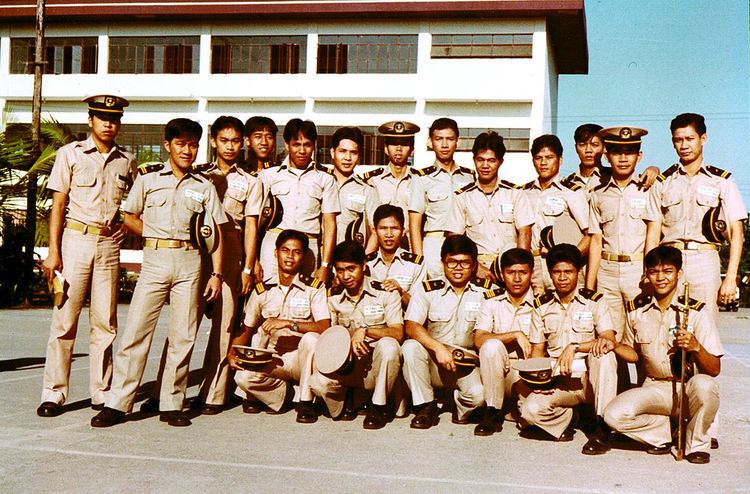Hex triplet #F0E68C HSV (h, s, v) (54°, 41%, 94%) | sRGB (r, g, b) (240, 230, 140) Source X11 | |
 | ||
Khaki ( /ˈkɑːkiː/, Canada and /ˈkækiː/) is a color, a light shade of yellow-brown. Khaki is a loanword incorporated from Hindustani (Urdu or Hindi) ख़ाकी/خاکی (meaning "soil-colored") and is originally derived from the Persian: خاک [xɒːk] (Khâk, literally meaning "soil"), which came to English from British India via the British Indian Army.
Contents
Khaki has been used by many armies around the world for uniforms, including camouflage. It has been used as a color name in English since 1848 when it was first introduced as a military uniform, and was called both drab and khaki—khaki being a translation of the English drab light-brown color. A khaki uniform is often referred to as khakis.
In Western fashion, it is a standard color for smart casual dress trousers for civilians, which are also often called khakis.
Origin
Khaki was first worn in the Corps of Guides that was raised in December 1846 as the brain-child of Sir Henry Lawrence (1806–1857) Resident at Lahore, and Agent to the Governor-General for the North-West Frontier. Lawrence chose as its commandant Sir Harry Lumsden supported by William Stephen Raikes Hodson as Second-in-Command to begin the process of raising the Corps of Guides for frontier service from British Indian recruits at Peshawar, Punjab.
Initially the border troops were dressed in their native costume, which consisted of a smock and white pajama trousers made of a coarse home-spun cotton, and a cotton turban, supplemented by a leather or padded cotton jacket for cold weather. For the first year (1847) no attempt was made at uniformity. Subsequently, in 1848 Lumsden and Hodson decided to introduce a drab (khaki) uniform which Hodson commissioned his brother in England to send them – as recorded in Hodson's book of published letters, Twelve Years of a Soldier's Life in India.
It was only at a later date, when supplies of drab (khaki) material was unavailable, did they improvise by dying material locally with a dye prepared from the native mazari palm. Some believe the gray drab/khaki color it produced was used historically by Afghan tribals for camouflaging themselves. The mazari could not, however, dye leather jackets and an alternative was sought: Cloth was dyed in mulberry juice which gave a yellowish drab shade. Subsequently, all regiments, whether British or Indian, serving in the region had adopted khaki uniforms for active service and summer dress. The original khaki fabric was a closely twilled cloth of linen or cotton.
Military use
The impracticality of the traditional scarlet coat, especially for skirmishing, was recognised early in the 19th century. Khaki-colored uniforms were used officially by British troops for the first time during the Abyssinian campaign of 1867–68, when Indian troops traveled to Ethiopia (Abyssinia) under the command of general Sir Robert Napier to release some British captives and to "persuade the Abyssinian King Theodore, forcibly if necessary, to mend his ways". Subsequently, the British Army adopted khaki for colonial campaign dress and it was used in the Mahdist War (1884–89) and Second Boer War (1899–1902).
During the Second Boer War, the British forces became known as Khakis because of their uniforms. After victory in the war the government called an election, which became known as the khaki election, a term used subsequently for elections called to exploit public approval of governments immediately after victories.
The United States Army adopted khaki during the Spanish–American War (1898). The United States Navy and United States Marine Corps followed suit.
When khaki was adopted for the continental British Service Dress in 1902, the shade chosen had a clearly darker and more green hue. This color was adopted with minor variations by all the British Empire Armies and the US expeditionary force of World War I, in the latter under the name olive drab. This shade of brown-green remained in use by many countries throughout the two World Wars. Khaki was devised to protect soldiers against the dangers of the industrialized battlefield, where the traditional bright colors and elaborate costumes made them vulnerable to attack. A response to surveillance technologies and smokeless guns, khaki could camouflage soldiers in the field of battle.
Use in civilian clothing
The trousers known as "khakis", which became popular following World War II, were initially military-issue khaki-colored chino cloth twill, used in uniforms and invariably khaki in color. Today, the term is sometimes used refer to the style of trousers based on these trousers, properly called chinos, regardless of their color.
Light khaki
At right is displayed the color light khaki (also called khaki tan or just tan).
It corresponds to Khaki in the X11 color names.
Khaki
This is the web color called khaki in HTML/CSS.
The color shown at right matches the color designated as khaki in the 1930 book A Dictionary of Color, the standard for color nomenclature before the introduction of computers.
Dark khaki
At right is displayed the web color dark khaki.
It corresponds to Dark Khaki in the X11 color names.
